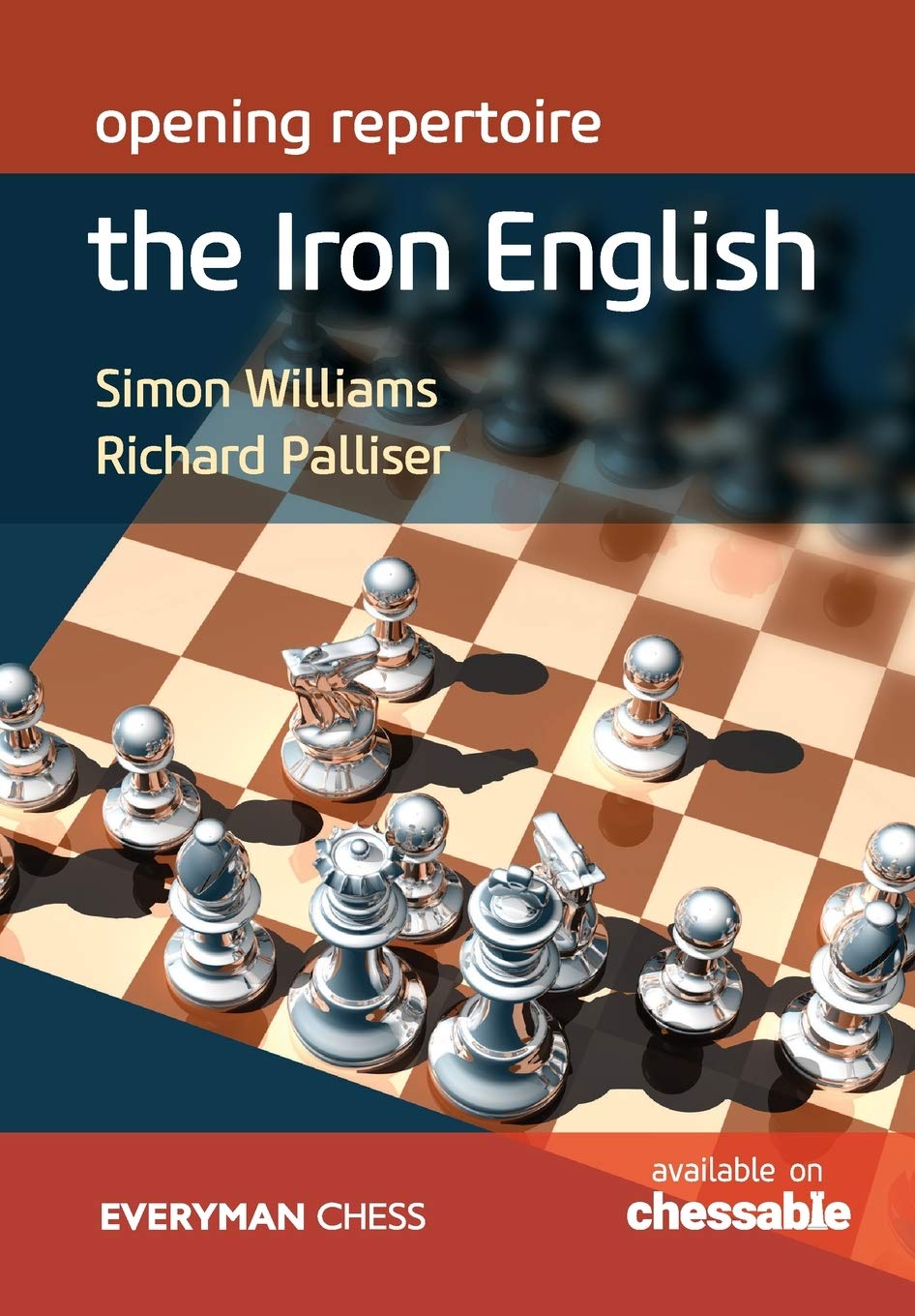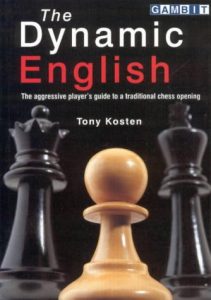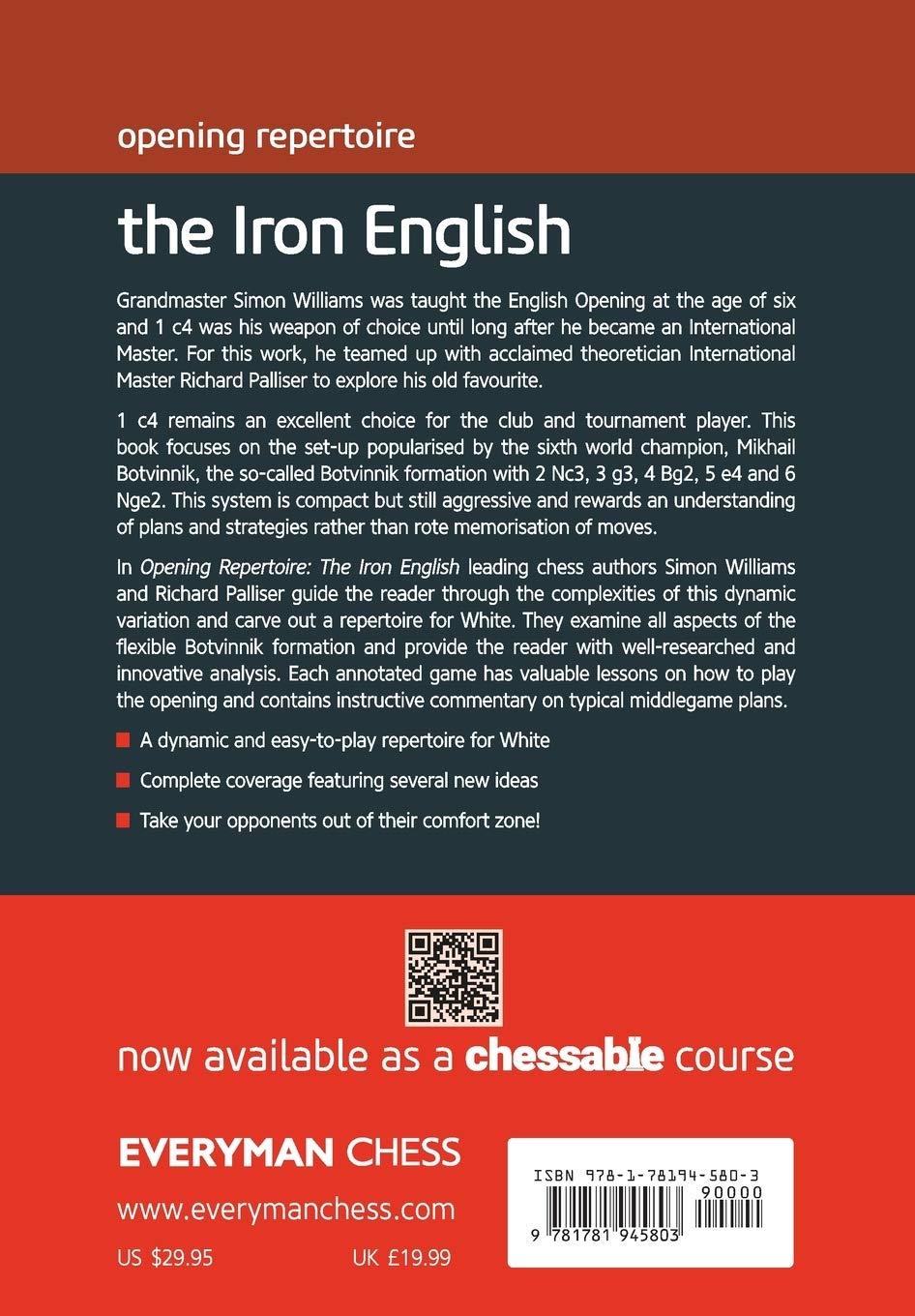
Here is the publishers blurb from the rear cover :
Grandmaster Simon Williams was taught the English Opening at the age of six and 1 c4 was his weapon of choice until long after he became an International Master. For this new work, he teamed up with acclaimed theoretician International Master Richard Palliser to explore his old favourite. 1 c4 remains an excellent choice for the club and tournament player. This book focuses on the set-up popularised by the sixth world champion, Mikhail Botvinnik, the so-called Botvinnik formation with 2 Nc3, 3 g3, 4 Bg2, 5 e4 and 6 Nge2.
This system is compact but still aggressive and rewards an understanding of plans and strategies rather than rote memorisation of moves. In Opening Repertoire: The Iron English leading chess authors Simon Williams and Richard Palliser guide the reader through the complexities of this dynamic variation and carves out a repertoire for White.
They examine all aspects of this highly complex opening and provide the reader with well-researched, fresh, and innovative analysis. Each annotated game has valuable lessons on how to play the opening and contains instructive commentary on typical middlegame plans.
and. from the publisher, about the authors :

“Richard Palliser is an International Master and the editor of CHESS magazine. In 2006 he became joint British Rapidplay Champion and in 2019 finished 3rd in the British Championship. He has established a reputation as a skilled chess writer and written many works for Everyman, including the bestselling The Complete Chess Workout.”

“Simon Williams is a Grandmaster, a well-known presenter and a widely-followed streamer, as well as a popular writer whose previous books have received great praise. He is much admired for his dynamic and spontaneous attacking style.”
As with every recent Everyman Chess publication high quality paper is used and the printing is clear. Each diagram is clear as is the instructional text. Figurine algebraic notation is used throughout.
The diagrams do not have a “to move” indicator or any kind of caption so you will need to work out for yourself how they relate to the text that they are embedded in. However, this is fairly obvious.
The book consists of nine chapters :
- Key Ideas for White
- Kickstarter: An Outline of the Iron English Repertoire
- English Versus King’s Indian
- The Modern: 1.c4 g6 and 1…d6
- Other Fianchetto Defences
- The Reversed Sicilian
- The Symmetrical English
- The Mikenas Attack
- Other Lines (1…c6/1…e6)
Opening books are becoming thicker and more imposing year on year and at 464 pages this recent offering from Everyman Chess is no exception. Any book with the involvement of Richard Palliser deserves, without doubt, to be paid special attention to and complimenting him is the h (and now f) pawns favourite advocate Grandmaster, Simon Williams.
Having two authors with contrasting playing styles (we felt) would lead to interesting recommendations rather in the vein of “Good cop, bad cop”. We will leave you to decide which might be which!
In essence this book (and the strongly associated Chessable course) is a complete repertoire for White based around the English Opening.
In the BCN office one of our favourite English Opening books is the 1999 classic “The Dynamic English” by Tony Kosten

which is of a mere 144 pages and of even smaller physical dimensions. A timeless classic in our opinion.
The Iron English is the first (we think) book (in the English language) to provide a complete repertoire around the Botvinnik flavour of the English in which White clamps or strongpoints the d5 square with an early e4 thus:
or even more simply
and this solid generic structure is advocated against almost all of Black’s reasonable and unreasonable defences.
Chapter One provides sample games (mainly from the authors) to give an idea of what White should be striving to achieve and Chapter Two outlines the repertoire.
In order to benefit from the chapters following these two should probably be read more than once. One of the reasons for this is the huge complexity of the transpositional possibilities and move orders. The end-of-book Index of Variations helps the reader to navigate their way through the mire of variations and following that is an Index of Games bringing up the rear.
The style of presentation is friendly and very, very chatty (Alan Carr is nowhere to be seen you’ll be pleased to learn) and presumably driven by the same material’s presentation as part of a Chessable course.
To get a feel of this style here are sample pages to whet your appetite and here is a example extracted game from Chapter One:
which provides for engaging instruction (if you like that sort of thing!).
Quite correctly, the content is dominated by the King’s Indian (73 pages), Reversed Sicilian (102 pages) and 100 pages on 1. c4 g6 and 1.c4 d6 lines. Clearly a wealth of material and probably most suited to someone who already plays the English but not the Botvinnik System. Taking up the English for the first time via this book (and/or the course) could well be somewhat daunting and not for the faint hearted.
Each of chapters Three – Nine adopts the now familiar Everyman format of example games delivering the theoretical discussion. Thirty-three games are dissected in detail including six of SKWs.
In the BCN office we always like to see how we would fair defending “against the book” and since we play the slightly offbeat 1.c4 c6 we turned to page 440 for Theory 9A (!).
where we won our internal wager that White would be advised to play 2.e4 and transpose into a Pseudo-Panov (called the Steiner Variation in Win with the Caro-Kann) rather than to a Slav. So, how did the “game” go?
1.c4 c6; 2. e4 d5; 3.cd: cd:; 4. ed: Nf6; 5.Nc3 Nxd5; 6.Bc4!?
which is a little off the beaten track (but easily met) with 6…Nb6; 7.Bb3 Nc6; 8.Nf3 Bf5; 9. d4 e6; 10 0-0, Be7; 11.a4 Na5 12. Ba2 0-0; 13.Qe2 and instead of the move suggested (13…Rc8) we played 13…Nc6! with a totally playable position.
The text suggests that someone who plays 1…c6 could be unfamiliar with a transposition to the Caro-Kann. Yes, they may well be but more likely this is a forlorn hope.
Anyway, this recreational digression is not really germane to the main thrust of the book…
In summary, this book is a major piece of work by Richard Palliser and Simon Williams that adds considerable material to the increasingly popular Botvinnik English.
In a sense the Botvinnik English is a kind of very grown-up London System and Colle Opening approach to playing with the White pieces (i.e. a system approach) and a welcome addition to White’s armoury. Anyone wishing to take it up will find this book to be a reliable and friendly companion.
John Upham, Cove, Hampshire, 29th April, 2021

Book Details :
- Paperback : 464 pages
- Publisher: Everyman Chess (1 Oct. 2020)
- Language: English
- ISBN-10: 1781945802
- ISBN-13: 978-1781945803
- Product Dimensions: 17.3 x 1.7 x 23.8 cm
Official web site of Everyman Chess
As is fairly common these days, the book has been migrated to the Chessable platform. Here are reviews of that course.





